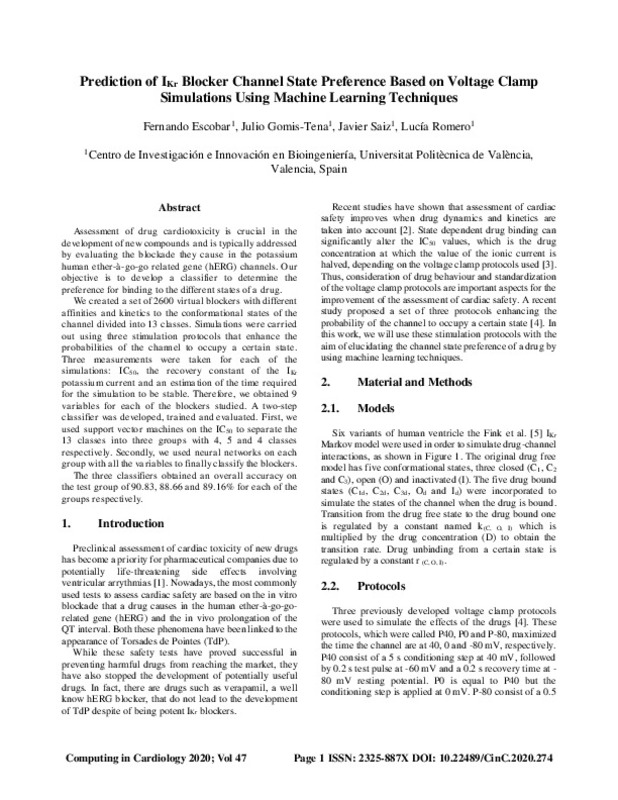JavaScript is disabled for your browser. Some features of this site may not work without it.
Buscar en RiuNet
Listar
Mi cuenta
Estadísticas
Ayuda RiuNet
Admin. UPV
Prediction of IKr Blocker Channel State Preference Based on Voltage Clamp Simulations Using Machine Learning Techniques
Mostrar el registro sencillo del ítem
Ficheros en el ítem
| dc.contributor.author | Escobar-Ropero, Fernando
|
es_ES |
| dc.contributor.author | Gomis-Tena Dolz, Julio
|
es_ES |
| dc.contributor.author | Saiz Rodríguez, Francisco Javier
|
es_ES |
| dc.contributor.author | Romero Pérez, Lucia
|
es_ES |
| dc.date.accessioned | 2022-01-18T08:13:11Z | |
| dc.date.available | 2022-01-18T08:13:11Z | |
| dc.date.issued | 2020-09-16 | es_ES |
| dc.identifier.issn | 2325-887X | es_ES |
| dc.identifier.uri | http://hdl.handle.net/10251/179852 | |
| dc.description.abstract | [EN] Assessment of drug cardiotoxicity is crucial in the development of new compounds and is typically addressed by evaluating the blockade they cause in the potassium human ether-à-go-go related gene (hERG) channels. Our objective is to develop a classifier to determine the preference for binding to the different states of a drug. We created a set of 2600 virtual blockers with different affinities and kinetics to the conformational states of the channel divided into 13 classes. Simulations were carried out using three stimulation protocols that enhance the probabilities of the channel to occupy a certain state. Three measurements were taken for each of the simulations: IC50, the recovery constant of the IKr potassium current and an estimation of the time required for the simulation to be stable. Therefore, we obtained 9 variables for each of the blockers studied. A two-step classifier was developed, trained and evaluated. First, we used support vector machines on the IC50 to separate the 13 classes into three groups with 4, 5 and 4 classes respectively. Secondly, we used neural networks on each group with all the variables to finally classify the blockers. The three classifiers obtained an overall accuracy on the test group of 90.83, 88.66 and 89.16% for each of the groups respectively. | es_ES |
| dc.language | Inglés | es_ES |
| dc.publisher | IEEE | es_ES |
| dc.relation.ispartof | CinC 2020: Program. Computing in Cardiology, vol. 47 | es_ES |
| dc.rights | Reconocimiento (by) | es_ES |
| dc.subject.classification | TECNOLOGIA ELECTRONICA | es_ES |
| dc.title | Prediction of IKr Blocker Channel State Preference Based on Voltage Clamp Simulations Using Machine Learning Techniques | es_ES |
| dc.type | Comunicación en congreso | es_ES |
| dc.type | Artículo | es_ES |
| dc.identifier.doi | 10.22489/CinC.2020.274 | es_ES |
| dc.rights.accessRights | Abierto | es_ES |
| dc.contributor.affiliation | Universitat Politècnica de València. Departamento de Ingeniería Electrónica - Departament d'Enginyeria Electrònica | es_ES |
| dc.description.bibliographicCitation | Escobar-Ropero, F.; Gomis-Tena Dolz, J.; Saiz Rodríguez, FJ.; Romero Pérez, L. (2020). Prediction of IKr Blocker Channel State Preference Based on Voltage Clamp Simulations Using Machine Learning Techniques. IEEE. 1-4. https://doi.org/10.22489/CinC.2020.274 | es_ES |
| dc.description.accrualMethod | S | es_ES |
| dc.relation.conferencename | 47th Computing in Cardiology Conference (CinC 2020) | es_ES |
| dc.relation.conferencedate | Septiembre 13-16,2020 | es_ES |
| dc.relation.conferenceplace | Rimini, Italia | es_ES |
| dc.relation.publisherversion | https://doi.org/10.22489/CinC.2020.274 | es_ES |
| dc.description.upvformatpinicio | 1 | es_ES |
| dc.description.upvformatpfin | 4 | es_ES |
| dc.type.version | info:eu-repo/semantics/publishedVersion | es_ES |
| dc.relation.pasarela | S\429622 | es_ES |








